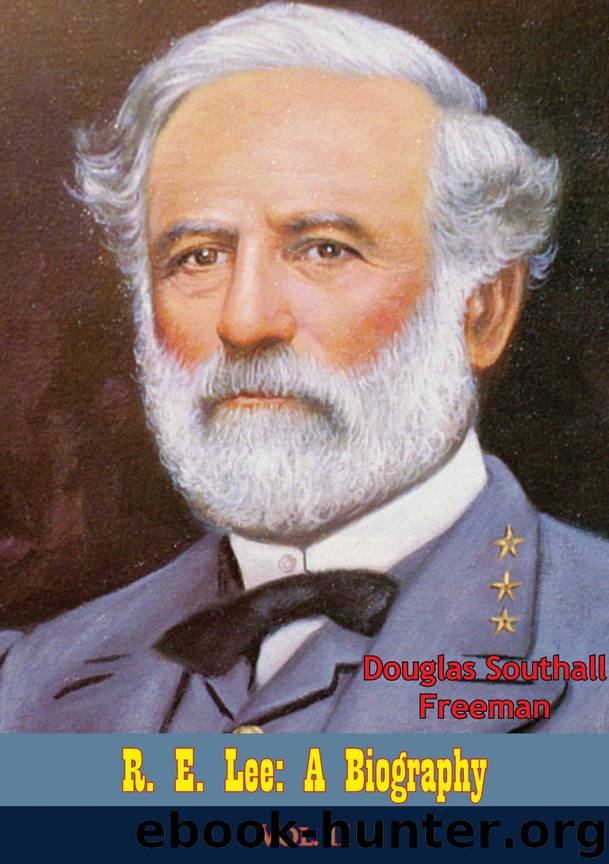R. E. Lee: A Biography, Vol. II by Freeman Douglas Southall;

Author:Freeman, Douglas Southall;
Language: eng
Format: epub
Publisher: Golden Springs Publishing
Published: 2016-07-19T04:00:00+00:00
At the designated time, the march began. Lee remained with Longstreet until time for that officer to move and then rode westward with him. The advance carried him through a quiet, rolling country toward South Mountain. This low and beautiful range, running almost with the meridian at this point, is part of the familiar Blue Ridge chain in Virginia, and forms an impressive barrier between Frederick and Hagerstown. As the veterans of Longstreet’s hard-hitting brigades passed through Turner’s Gap in the mountains, reminiscent of the highlands through which they had tramped to Manassas, every soldier must have reflected that the nearby heights would make a good fortress from which to defy McClellan. But as Lee expected the speedy conclusion of the Harpers Ferry expedition, he had no thought of holding the mountain pass. On the contrary, it seemed more to his advantage to draw McClellan westward beyond the range, so that he would have to negotiate it in victualling his army.{1366} At the least, Lee intended to move on to Boonsboro, two miles and a half from the crest of the mountains. From that point he could observe the progress of the operations against Harpers Ferry, and could advance quickly if the Federals at the Ferry eluded McLaws and tried to join McClellan.
Before the 10th of September ended, a rumor reached Lee that a Federal force was moving southward on Hagerstown from the direction of Chambersburg, Penna. This had not been reckoned upon. If it were a fact, the Federals could cross in front of Lee’s column and play havoc with his communications or interrupt the operations against Harpers Ferry. Hagerstown must be secured. Longstreet was therefore directed to proceed thither the next day, instead of remaining at Boonsboro.
Lee was loath, however, to abandon altogether the strategic position at Boonsboro until he was certain that the Federals at Harpers Ferry had been bagged, for there was no other point from which he could move so quickly toward Harpers Ferry in case of emergency. Besides, Stuart might need infantry support closer than Hagerstown. Reasoning in this way, Lee determined to leave D. H. Hill at Boonsboro while Longstreet went on to Hagerstown.{1367} This meant splitting the army into five detachments—Jackson en route to Martinsburg, McLaws moving toward Maryland Heights, Walker on his way to Loudoun Heights, Longstreet advancing to Hagerstown, and D. H. Hill remaining at Boonsboro, while the cavalry, as yet, was east of South Mountain. Still, so long as McClellan lingered under the shelter of the Washington defenses, a dispersion of force that violated all the canons of war might serve the needs of the situation and involve no undue risks.
Lee rode on with Longstreet to Hagerstown on the 11th. He found no signs of any Federal advance from Pennsylvania and nothing to create alarm. The reception of the army was more sympathetic than at Frederick,{1368} but the stiffest discipline was maintained among the men for the protection of hostile civilians in accordance with the spirit of Lee’s proclamation.
Download
This site does not store any files on its server. We only index and link to content provided by other sites. Please contact the content providers to delete copyright contents if any and email us, we'll remove relevant links or contents immediately.
Waking Up in Heaven: A True Story of Brokenness, Heaven, and Life Again by McVea Crystal & Tresniowski Alex(37497)
Still Foolin’ ’Em by Billy Crystal(36056)
Cecilia; Or, Memoirs of an Heiress — Volume 1 by Fanny Burney(32075)
Cecilia; Or, Memoirs of an Heiress — Volume 3 by Fanny Burney(31469)
Cecilia; Or, Memoirs of an Heiress — Volume 2 by Fanny Burney(31419)
Fanny Burney by Claire Harman(26252)
Empire of the Sikhs by Patwant Singh(22775)
We're Going to Need More Wine by Gabrielle Union(18644)
Hans Sturm: A Soldier's Odyssey on the Eastern Front by Gordon Williamson(18333)
Plagued by Fire by Paul Hendrickson(17119)
Out of India by Michael Foss(16695)
All the Missing Girls by Megan Miranda(14791)
Cat's cradle by Kurt Vonnegut(14779)
Molly's Game by Molly Bloom(13893)
Pimp by Iceberg Slim(13800)
Bombshells: Glamour Girls of a Lifetime by Sullivan Steve(13700)
Leonardo da Vinci by Walter Isaacson(12813)
4 3 2 1: A Novel by Paul Auster(11813)
The Radium Girls by Kate Moore(11636)
